
Cauterizing Tools Page Menu: 1 2 3 4 5 6 Next>>
Cauterizing Tools of the Golden Age of Piracy, Page 3
Potential Cauteries: Lixivium (Lye/Caustic Soda/Sodium Hydroxide)
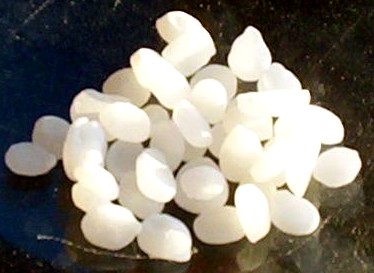
Photo: Wiki user Walkerma - Sodum Hydroxide Pellets
While lixivium or lye is a component used to create caustic stones, it also was used as a standalone potential cautery. Jacques Guillemeau gives a procedure for making "goode Lixivye, onlye of Oacken ashes, or of Ashes of Vinebranches, whe[n] as the same is wel sodde[n] with potashes [potassium carbonate], and of Beanestrawe, addinge therunto a little unslissed [unslaked] lime [calcium oxide], whereof we may make verye excellent good Cautereyes."1
John Woodall also refers to it as "the liquid causticke" explaining that it is "made only of unslaked lime and strong Capitall lees [potash] by decoction together to the thicknesse of an unguent"2. He further notes that 'lye made of ashes' is the best caustic medicine (potential cautery).3
When using lixivium as a caustic, Woodall advises the surgeon to "lay on the griefe a minium [red lead or lead tetraoxide] or some other cleaving [sticking] Emplaster with a hole cut therein, so bigge as there shall be occasion to make an orifice, and thicke spread the white causticke thereon, & let it remaine thereon at the least two houres, having a care so to defend the same that it doe not spread."4 The purpose of the sticking plaster was to protect the skin outside of the hole from the lye.
1 Jacques Guillemeau, The French Chirurgerie, p. 42; 2 John Woodall, the surgions mate, p. 63; 3 Woodall, p. 322; 4 Woodall, p. 42
Potential Cauteries: Mercury Sublimate (Mercury Chloride)
Physician James Rennie

Sublimating Equipment from the works of
Gerber. The curcubit is the globe with a
stem atop the furnace.
explains that mercury sublimate is created by combining {2 pound} by weight of purified mercury, {30 ounces) by weight of sulphuric acid, {4 pounds} of dried muriate of soda... [boiling them in sulfuric acid] ...in a glass vessel, until the sulphate of mercury is dry; rub this when it is cold with muriate of soda in an earthenware mortar, then sublime [change from a solid to a gas] from a glass cucurbit by heat gradually increased."1 The result, which was also referred to as 'corrosive sublimate' was "acrid [strong and bitter], styptic [stopped bleeding], corrosive [caustic], stimulant, alterative [restored health], and antisiphilitic, and is used as a powerful remedy in syphilis and cutaneous disorders."2
Physician Stephen Bradwell advised opening the wound site of a mad dog bite when the wound would not bleed to force 'the contagion' out. He suggested "an eating Medicine as [mercury] Sublimate mixed with some cold thing, that it may be lesse painfull"3. By 'cold' Bradwell was referring here to humor theory which assigned degrees of heat, cooling, dryness and moisture to elements found in nature. Using this theory, Mercury (a hot medicine), would theoretically by tempered by a cold medicine.
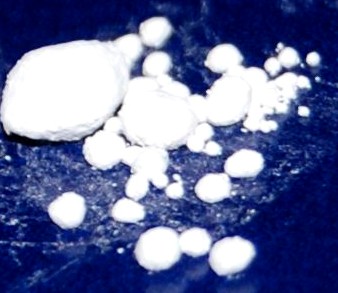
Photo: David Aldridge - Mercury Sublimate
While reviewing ways to stop bleeding, sea surgeon James Yonge explains that one way to do this is "by inducing an Eschar, or Crust, by which the bleeding mouth of the Vessel is choked"4. One of the potential cauterizing agents he suggests are "Mercurius sublimates corrosives"5. Fellow sea surgeon John Atkins also recommends it as a potential cautery for the same purpose.6
Not all the sea surgeon writers are in agreement on the use of mercury sublimates for such simple purposes, however. John Woodall warns against the "grosse custome" of using "precipitated Mercurie, or other the like Causticke medicines, and put them into wounds to mundifie, and also the better to digest them."7 Woodall recommends "if neither feare of a Gangrene be, neither broken bones to be taken out, there is not cause of any Causticke medicines to be applied for the curing of a new wound at no time. "8
1 James Rennie, A New Supplement to the Pharmacopœpias of London, Edinburgh, Dublin and Paris, Baldwin and Cradock, p. 177; 2 Rennie, p. 178; 3 Stephen Bradwell, Helps For Suddain Accidents Endangering Life, p.60; 4 James Yonge, Currus Triumpalis, é Terebinthô., p. 9-10; 5 Yonge, p. 10; 6 John Atkins, The Navy Surgeon, p. 121; 7 John Woodall, the surgions mate, p. 144; 8 Woodall, p. 145
Potential Cauteries: Moxa
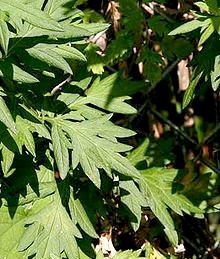
Photo: Sue Sweeny - Mugwort
Moxa is a very unusual form of cautery, one that probably does not truly belong to the classification of potential cauteries. However, it is similar in many ways to the heated substances, so it has been placed here.
James Rennie explains that moxabustion is the forming of material into "a cone about an inch long. This is set fire to, and placed upon the skin, which it gradually burns."1 German surgeon Matthias Gottfried Purmann says that moxa is "prepared Wool, from an Herb not much unlike our Artemisia or Mugwort, only it had something a Broader Leaf."2 However, Rennie finds that the moxa cone may be made of "many different substances, such as the down of several species of Artermisia [a plant genus which includes mugwort, wormwood, and sagebrush], cotton wool, Eriopheron spike [Eriophorum - cotton grass], & c."3 Dried mugwort is typically used in the orient, (Japan, Korea, Vietnam, and Mongolia) where the procedure originated.4
According to Purmann, the surgeon prepares moxa similarly - first by drying it in the shade, after which he is to "stamp
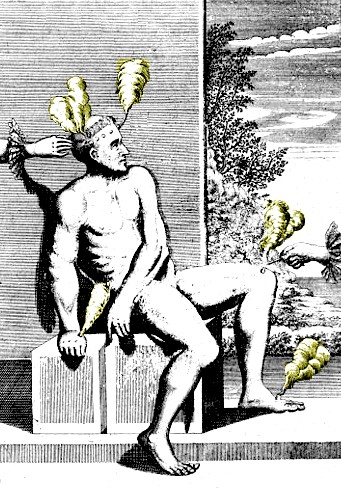
Artist: Michael Bernhard Valentini
Moxa Being Used on a Patient in Several Places
them with a Wooden Pestle, or run them between your hands till the Outward Rinde is separated, and nothing remains but the inward Ianugo [fine, soft material], which being diligently Kernled [removed from the center] will appear like Wool, insomuch that none would ever take it to have been an Herb."5
It is then rolled into "a Pyramid about the bigness of a half a Nutmeg, narrow at top and broad at Bottom that it may stand fast upon the Skin, this being placed where it ought to be, the set it on fire with an Wax Candle, which quickly burns and Smoaks (but never flames) till it is consumed to Ashes, which being blown away, leaves a yellow spot in the place where the Moxa burnt"6.
Purmann lists five uses for moxa - 1) To be put on joints and where there is swelling or tumors. 2) To open pores and removes pain in the Periostium. 3) To dissolve "Malignant, Acrid, and soure Humours". 4) To remove bad humors found in the periostium. and 5) To strengthen the place where it is used, allowing resistance to bad humors.7 Most of these things are dubious, given what we know today, but they would appeal to a period surgeon.
Purmann suggests that an advantage of moxa is that "The Pain of this burning is very inconsiderable and continues not a quarter of a Minute, and then the pain vanishes also."8 Although this seems amazing given the way it is applied, if it were true, it would satisfy many of the patients who would choose potential cauteries over actual ones. Yet Purmann is the only period surgeon under study who talks about it. Rennie, writing decades after Purmann, dismisses it as a fad, noting that moxa "has lately come into repute, but it has little chance to continue so, in consequence of the prejudice of patients."9 It is rather unlikely such a thing would be used on a ship given it's rarity and the fact that it had to be lit, but it is still an interesting potential cautery.
1 James Rennie, A New Supplement to the Pharmacopœpias of London, Edinburgh, Dublin and Paris, Baldwin and Cradock, p. 256;2 Matthias Gottfried Purmann, Churgia Curiosa, p. 306; 2 Rennie, p. 268; 4 Moxibustion, wikipedia, gathered 8/16/13; 6 Purmann, p. 306-7; 7 Purmann, p. 307; 8 Purmann, ibid.; 8 Purmann, p. 306; 9 Rennie, p. 268;
Potential Cauteries: Vitriol
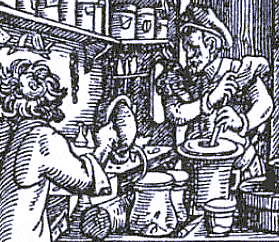
Artist: Jost Amman - The Apothecary (1586)
Vitriol had wide support from the sea surgeon writers as a potential cautery. While explaining how amputation should be performed, John Atkins declared that "the Pul. Vitriol. Roman. is the readiest and the best: A thick Pledget or Button is first to be pressed out of warm Ol. Terebinth. [turpentine] and when sprinkled or dipped in this Powder, applied to the Mouth of the Artery."1
'Vitriol' was used to refer to various sulfates [sulfuric acid combined with different metals]. Physician James Rennie explains that the term was "applied to suphate of iron, which was called green vitriol; to suphate of copper, which was called blue vitriol; to sulphate of zinc, which was called white vitriol, and to sulphuric acid, which was called oil of vitriol, or simply vitriol."2
Potential Cauteries: Blue Vitriol (Copper Sulfate)
While
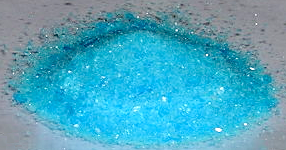
Photo: Petr Adam Dohnálek - Blue Vitriol
most of the sea surgeons call for blue vitriol as a potential cautery, they each refer to it in a different way. For example, in the above quote, Atkins recommended 'Pulv. Vitriol Roman' which is the same as 'powdered blue vitriol' - copper sulfate. John Woodall refers to copper sulfate variously as blue vitriol and "burnt vitriol." James Yonge uses the term "Vitriolum ustum"3 which is, of course, Latin for 'burnt vitriol' when suggesting a potential cautery to stop bleeding.
Rennie gives the recipe for burnt vitriol, noting that it is "prepared by dissolving one part of copper-filings in two parts of sulphuric acid."4 He notes that it is used "externally
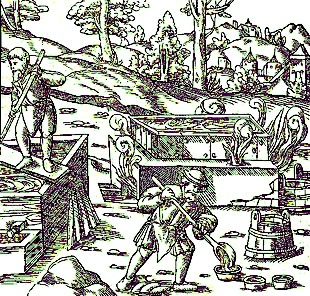
Artist: Peter Schmidt - Recovering Vitriol (1580)
as a stimulant, styptic, and escharotic, for warts, fungous and phagedenic ulcers, hemorrhages, asthma, and in ulcerated sore throat, applied with a camel-hair pencil, twice or thrice a day."5
When a gunshot wound requires cauterizing, Woodall advises that the surgeon "adde some burnt Vitriole, and foment somewhat the outward parts of the griefe with hot Lixivium, and apply a hot stupe wet in the Lixivium & wrung out round about the member:"6 He later explains that burnt vitriol "is of great use in Surgerie, namely, to abate [reduce] spungie flesh in ulcers, and also in all restrictive powder for staying of fluxes [diarrheas], and it helpeth well with other simples fitting to siccatrize [cicatrize - heal with a scar], and also in Lotions and Gargarismes, as is sayd, it is of good use."7 Similar to Yonge, he also tells his readers that burnt vitriol "maketh a strong Esker: and often restraineth great Fluxe [copious bleeding] [when] applyed thereon."8
Potential Cauteries: Oil of Vitriol (Sulfuric Acid)
Oil of Vitriol
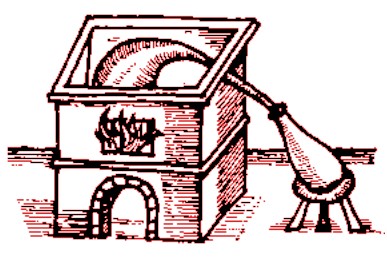
Retort and Receiver, Used to Make Oil of Vitriol
From John French's
The Art of Distillation (1651)
(Sulfuric acid) can also be directly applied to serve as a potential cautery. No less than Ambrois Paré recommends it in this capacity.9
Sea surgeon John Moyle suggests its use during amputation, explaining that "if you first dip your Buttons in the Aqua styptica Vitriola, and then arm them [with another cauterizing agent], it is a good way. The Buttons applied, let an assistant hold them on with his fingers ends."10
There are two things of note here. First, Moyle doesn't seem to feel that sulfuric acid is strong enough on it's own, recommending it be used in addition to another potential cautery. Second, in keeping with the general tone of things, he gives it a new name, referring to it as 'Aqua styptica Vitriola". (I guess they felt it was best to always keep your audience guessing when it came to vitriol.)
Despite Paré's firm recommendation, however, most of the period surgeons seem to use it internally or as a support for other medications as Moyle explains. John Woodall discusses Oil of Vitriol without ever mentioning it being used as a potential cautery, instead advising the reader that it should be "mixed in waters, decoctions, sirupes or conserves, maketh them in taste tart of sowerish, and in colour purple like, delighting them that are sicke of feavers, freeth obstructions, recreateth the bowels: and is very effectuall in the pestilence, falling sicknesse palsie and stopping of urine."11
1 John Atkins, The Navy Surgeon, p. 121; 2 James Rennie, A New Supplement to the Pharmacopœpias of London, Edinburgh, Dublin and Paris, Baldwin and Cradock, p. 475; 3 James Yonge, Currus Triumpalis, é Terebinthô., p. 10; 4 Rennie, p. 100; 4 Rennie, p. 101; 6 John Woodall, the surgions mate, p. 144; 7 Woodall, p. 285; 8 John Woodall, Woodalls Viaticum, p. 7; 9 Ambroise Paré, The Workes of that Famous Chirurgion Ambrose Parey, p.485; 10 John Moyle, Abstractum Chirurgæ Marinæ, p. 26; 11 Woodall, the surgions mate, p. 74
Potential Cautery Storage
A particular problem with potential cauteries was implicit in their ability to burn: they had to be stored in a way which would keep them from burning through their containers and ruining the other medicines in the ship surgeon's tightly-packed chest.
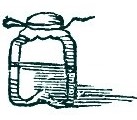
Glass Vial for Storing
Cautery Stones from
Pierre Dionis (1740)
Pierre Dionis recommended that after surgeons created his caustic stones, they "put [them] into Glass Vials, and stopping them very well, keep them in a warm and dry place."1 He must have felt this was important, because he even supplied the figure of the jar in which they should be kept.
One problem with glass vials, particularly on a ship, is that they could break. It may be for this reason that John Woodall advised his readers to store cauterizing agents in metal tubes, which he called burras pipes.
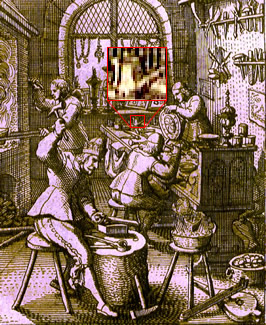
Goldsmiths With a Possible Burras Box Shown
Expanded in the Inserted Red Box (Mid 17th c.)
This Instrument thus named doubtlesse was by a Surgeon borrowed at first from some Gold or Silver-smith, and never paid him againe; for the Goldsmiths use it daily, and cannot performe their workes without a Burras pipe, but the Surgeons make other use thereof, namely for the most part to reteyne corroding powders in, as Vitrioll, burnt Allom præcipitate, and such other causticke medicines2
Woodall's comment about the device being 'borrowed' from gold and silversmiths actually suggests that the device was just a little more complex than a simple pipe. Randle Holme explained that "The Borax Box; of some termed a Borace Box; but more vulgarly a Burras Box, is a Brass or Copper Box with a Pipe in the side, in which bruised Borax is put, to scratch it by little and little out of the Knobbed Pipe, on the place intended to be Soddered [soldered by the gold and silversmiths]."3
However, Surgeon James Cooke provided a much simpler definition, explaining that the stitching quill (or cannula), needles and burras pipe "may [all] be included in one [instrument]... The burras pipe is to preserve in it corroding powder,
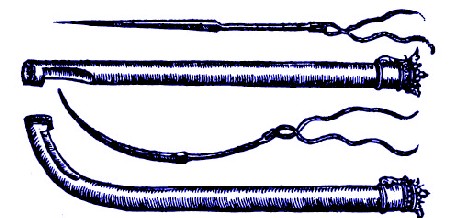
Suture Needles and Cannula Pipes - The Right Side of the Tubes are Hollow
With Caps on the End To Keep Items Inside the Tube (Needles & Cauteries),
From The Workes of that Famous Chirurgion Ambrose Parey, p256 (1649)
as [mercury] precipitate, turbith mineralis, burnt allum &c. to cast on proud flesh [flesh growing where it shouldn't in a healing wound], appearing in the wounds and ulcers."4
What is important about this comment is that he says a cannula can function as a burras pipe. Seen here, the cannula is a metal tube, made from steel or possibly silver, that has a cap on the back end of it to keep what is put into the pipe inside. (The caps look a bit like crowns.)
However, in 1753, a cyclopedia said that the original burras box was "sometimes also used by surgeons for the application of certain solid medicines by inspersion [sprinkling on]"5. This suggests that the while the cannula would make a more compact method of sprinkling caustic on the skin, the smiths' device still may not have been fully supplanted by the cannula during the golden age of piracy.
1 Pierre Dionis, A course of chirurgical operations: demonstrated in the royal garden at Paris. 2nd ed., p. 468; 2 Randle Holme, The acadamy of armory, Volume 2, 1688, p. 308; 3 John Woodall, the surgions mate, p. 31; 4 James Cooke, Supplementum Chirurgiae, 1655, p. 419-21; 5 "Burras-Pipe", A Supplement to Mr. Chambers's Cyclopædia, 1753, Volume 1, Burning - Bursalis, not pagineated

